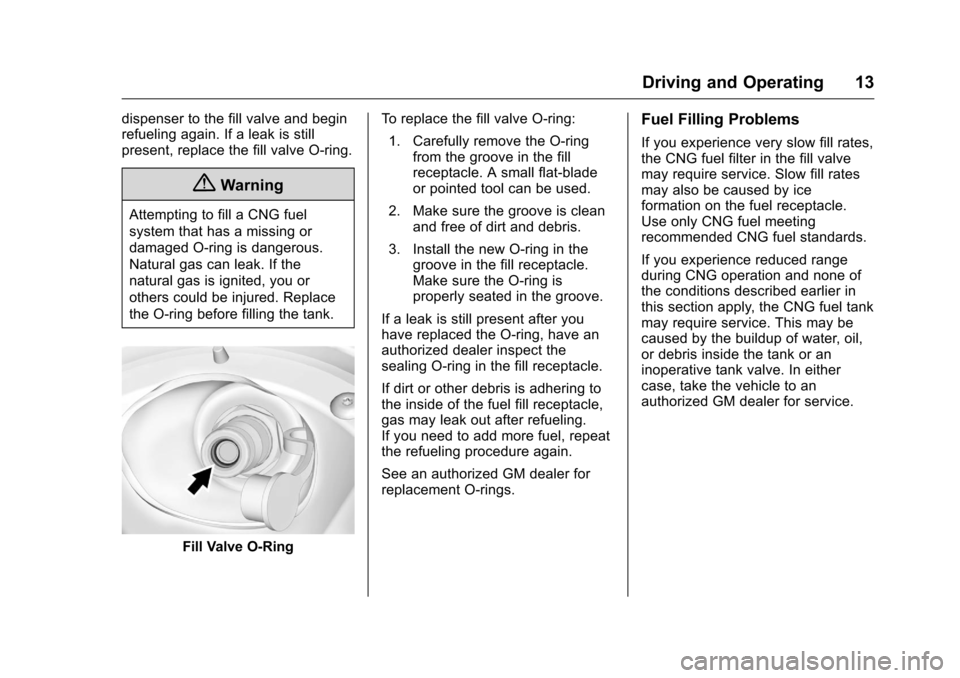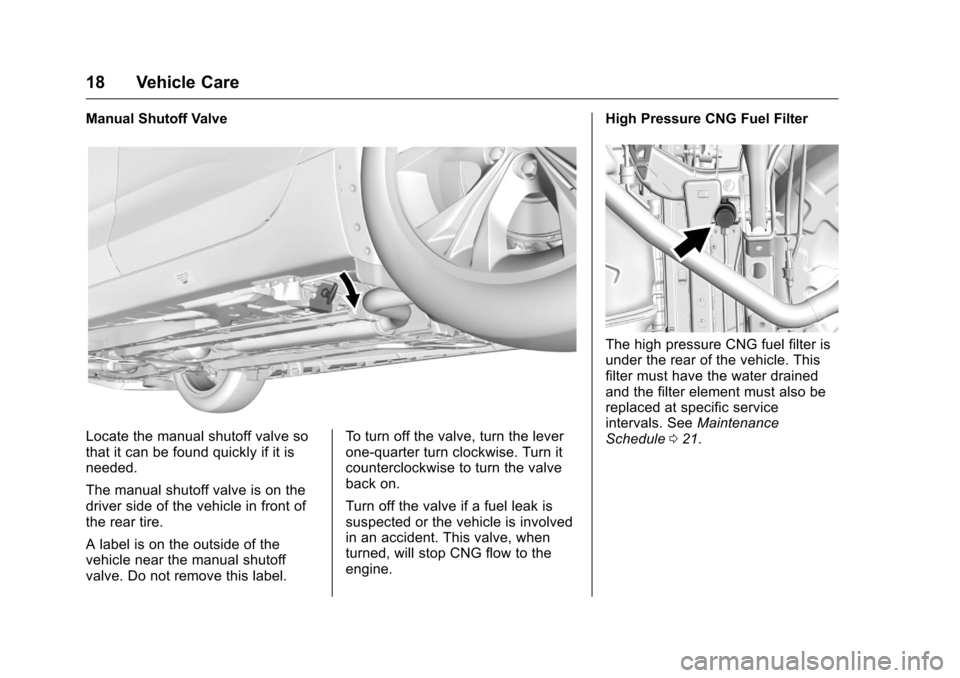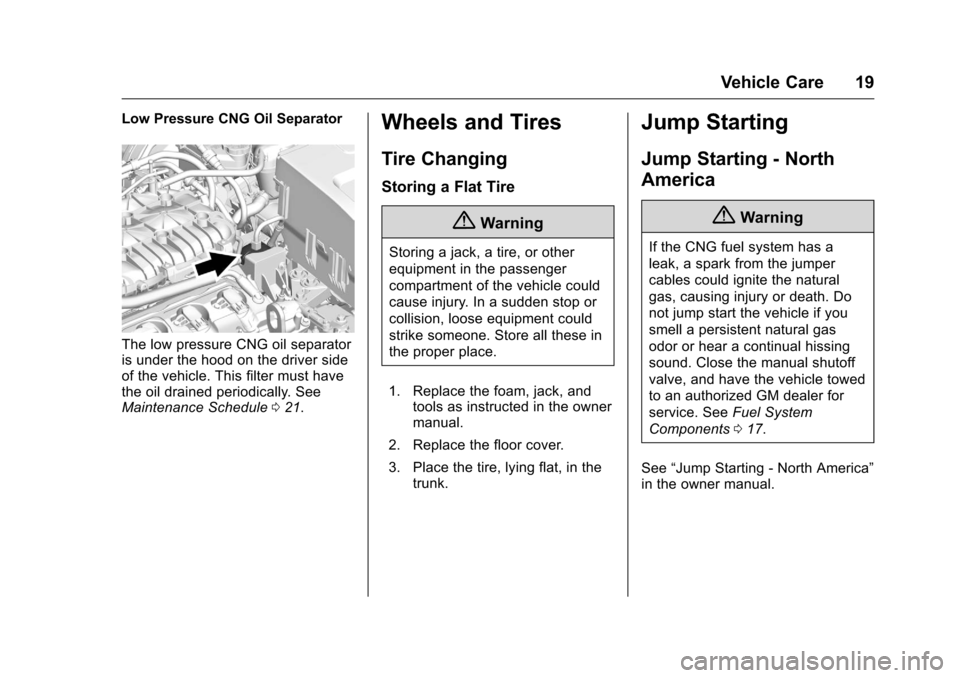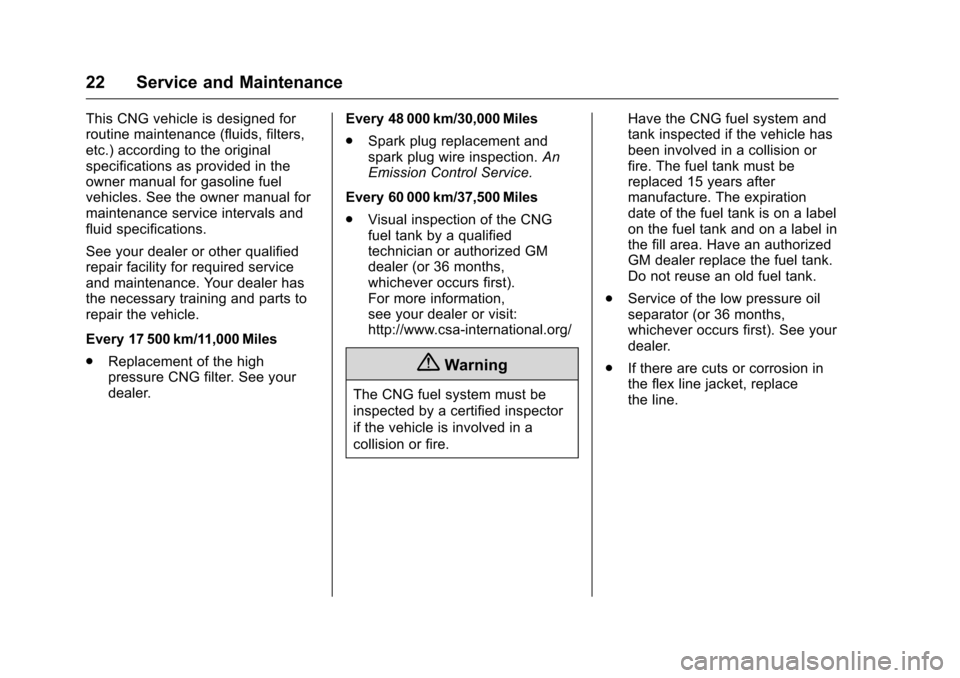2016 CHEVROLET IMPALA fuel filter
[x] Cancel search: fuel filterPage 10 of 29

Chevrolet Impala Bi-Fuel (Gasoline/CNG) Supplement (GMNA-Localizing-U.
S/Canada-9087624) - 2016 - CRC - 8/17/15
Driving and Operating 9
standards for general marketplace
vehicle usage; however, CNG is
available at both private and public
filling stations. We recommend use
of CNG that meets or exceeds SAE
J1616 specifications for fuel
composition and cleanliness. See
Filling the Tank (CNG)09.
Caution
Using below standard CNG fuel
quality may cause damage to the
CNG fuel system. Use only CNG
fuel meeting recommended CNG
fuel standards.
The main component of CNG is
methane, a highly flammable,
colorless gas. An odorant has been
added for detection through smell.
The smell is similar to that of rotten
eggs. The CNG in the vehicle is
stored under high pressure
(maximum 24 800kPa at 21 °C/
3,600 psig at 70 °F). Gas should
never be smelled unless it occurs
briefly during refueling. If gas is
smelled or a hissing sound is heard
at any other time, park in a well ventilated outdoor open area, shut
down the vehicle, and have it
serviced.
It may be possible to hear the fuel
flowing while the engine is running if
standing close to the pipework or
various fuel system components
(regulator, filter). This is normal and
should not be confused with a
hissing sound at fittings that may
indicate a fuel leak. If you suspect a
fuel leak, follow the instructions
under
Fuel System Leak 014.
Fuel Selector Switch
The fuel selector switch is on the
instrument panel left of the steering
wheel. When the ignition is in ON/
RUN, press
0to select between
gasoline and CNG. The indicator
light in the fuel selector switch
comes on when the vehicle is
running on CNG.
Certain conditions must be met in
order to switch between gasoline
and CNG. The vehicle will start up
on the last fuel that was selected.
When the fuel selector switch is
pressed, the indicator light will flash
during a fuel transition. If the fuel
transition is unsuccessful, the DIC
will display FUEL MODE
UNAVAILABLE. See Fuel System
Messages 06.
Filling the Tank (CNG)
{Warning
CNG is flammable and highly
explosive. You could be killed or
seriously injured if leaking natural
(Continued)
Page 14 of 29

Chevrolet Impala Bi-Fuel (Gasoline/CNG) Supplement (GMNA-Localizing-U.
S/Canada-9087624) - 2016 - CRC - 8/17/15
Driving and Operating 13
dispenser to the fill valve and begin
refueling again. If a leak is still
present, replace the fill valve O-ring.
{Warning
Attempting to fill a CNG fuel
system that has a missing or
damaged O‐ring is dangerous.
Natural gas can leak. If the
natural gas is ignited, you or
others could be injured. Replace
the O‐ring before filling the tank.
Fill Valve O-RingTo replace the fill valve O-ring:
1. Carefully remove the O-ring from the groove in the fill
receptacle. A small flat-blade
or pointed tool can be used.
2. Make sure the groove is clean and free of dirt and debris.
3. Install the new O-ring in the groove in the fill receptacle.
Make sure the O-ring is
properly seated in the groove.
If a leak is still present after you
have replaced the O-ring, have an
authorized dealer inspect the
sealing O-ring in the fill receptacle.
If dirt or other debris is adhering to
the inside of the fuel fill receptacle,
gas may leak out after refueling.
If you need to add more fuel, repeat
the refueling procedure again.
See an authorized GM dealer for
replacement O-rings.
Fuel Filling Problems
If you experience very slow fill rates,
the CNG fuel filter in the fill valve
may require service. Slow fill rates
may also be caused by ice
formation on the fuel receptacle.
Use only CNG fuel meeting
recommended CNG fuel standards.
If you experience reduced range
during CNG operation and none of
the conditions described earlier in
this section apply, the CNG fuel tank
may require service. This may be
caused by the buildup of water, oil,
or debris inside the tank or an
inoperative tank valve. In either
case, take the vehicle to an
authorized GM dealer for service.
Page 19 of 29

Chevrolet Impala Bi-Fuel (Gasoline/CNG) Supplement (GMNA-Localizing-U.
S/Canada-9087624) - 2016 - CRC - 8/17/15
18 Vehicle Care
Manual Shutoff Valve
Locate the manual shutoff valve so
that it can be found quickly if it is
needed.
The manual shutoff valve is on the
driver side of the vehicle in front of
the rear tire.
A label is on the outside of the
vehicle near the manual shutoff
valve. Do not remove this label.To turn off the valve, turn the lever
one-quarter turn clockwise. Turn it
counterclockwise to turn the valve
back on.
Turn off the valve if a fuel leak is
suspected or the vehicle is involved
in an accident. This valve, when
turned, will stop CNG flow to the
engine.High Pressure CNG Fuel Filter
The high pressure CNG fuel filter is
under the rear of the vehicle. This
filter must have the water drained
and the filter element must also be
replaced at specific service
intervals. See
Maintenance
Schedule 021.
Page 20 of 29

Chevrolet Impala Bi-Fuel (Gasoline/CNG) Supplement (GMNA-Localizing-U.
S/Canada-9087624) - 2016 - CRC - 8/17/15
Vehicle Care 19
Low Pressure CNG Oil Separator
The low pressure CNG oil separator
is under the hood on the driver side
of the vehicle. This filter must have
the oil drained periodically. See
Maintenance Schedule021.
Wheels and Tires
Tire Changing
Storing a Flat Tire
{Warning
Storing a jack, a tire, or other
equipment in the passenger
compartment of the vehicle could
cause injury. In a sudden stop or
collision, loose equipment could
strike someone. Store all these in
the proper place.
1. Replace the foam, jack, and tools as instructed in the owner
manual.
2. Replace the floor cover.
3. Place the tire, lying flat, in the trunk.
Jump Starting
Jump Starting - North
America
{Warning
If the CNG fuel system has a
leak, a spark from the jumper
cables could ignite the natural
gas, causing injury or death. Do
not jump start the vehicle if you
smell a persistent natural gas
odor or hear a continual hissing
sound. Close the manual shutoff
valve, and have the vehicle towed
to an authorized GM dealer for
service. See Fuel System
Components 017.
See “Jump Starting - North America”
in the owner manual.
Page 23 of 29

Chevrolet Impala Bi-Fuel (Gasoline/CNG) Supplement (GMNA-Localizing-U.
S/Canada-9087624) - 2016 - CRC - 8/17/15
22 Service and Maintenance
This CNG vehicle is designed for
routine maintenance (fluids, filters,
etc.) according to the original
specifications as provided in the
owner manual for gasoline fuel
vehicles. See the owner manual for
maintenance service intervals and
fluid specifications.
See your dealer or other qualified
repair facility for required service
and maintenance. Your dealer has
the necessary training and parts to
repair the vehicle.
Every 17 500 km/11,000 Miles
.Replacement of the high
pressure CNG filter. See your
dealer. Every 48 000 km/30,000 Miles
.
Spark plug replacement and
spark plug wire inspection. An
Emission Control Service.
Every 60 000 km/37,500 Miles
. Visual inspection of the CNG
fuel tank by a qualified
technician or authorized GM
dealer (or 36 months,
whichever occurs first).
For more information,
see your dealer or visit:
http://www.csa-international.org/
{Warning
The CNG fuel system must be
inspected by a certified inspector
if the vehicle is involved in a
collision or fire. Have the CNG fuel system and
tank inspected if the vehicle has
been involved in a collision or
fire. The fuel tank must be
replaced 15 years after
manufacture. The expiration
date of the fuel tank is on a label
on the fuel tank and on a label in
the fill area. Have an authorized
GM dealer replace the fuel tank.
Do not reuse an old fuel tank.
. Service of the low pressure oil
separator (or 36 months,
whichever occurs first). See your
dealer.
. If there are cuts or corrosion in
the flex line jacket, replace
the line.